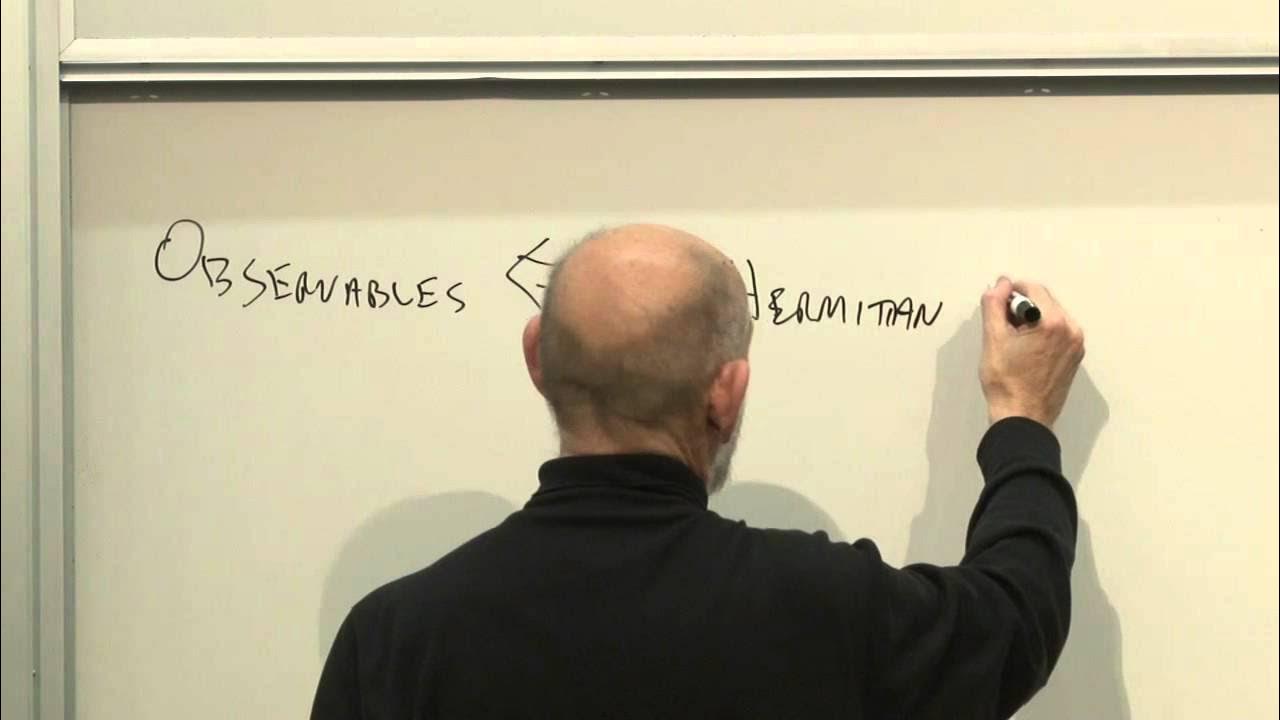Ch 2: What are kets and wavefunctions? | Maths of Quantum Mechanics
TLDRThis episode delves into the mathematical formalism of representing particles as vectors in a vector space, essential for understanding quantum mechanics. It explains the abstract concept of a vector space and its relevance to quantum states, which encapsulate a particle's physical properties. The script introduces the notation of 'kets' for quantum vectors and explores how linear combinations of kets represent superpositions of possible outcomes. It also addresses the challenge of representing continuous physical quantities like position, using integrals and wavefunctions as the coefficients in the linear combination over a continuous set of outcomes.
Takeaways
- 📐 The justification for using linear algebra in quantum mechanics is based on representing particles as vectors and physical quantities as linear operators.
- 🌟 Particles are represented by vectors in a vector space, embodying superpositions of all possible measurement outcomes.
- 📊 A vector space is a mathematical structure with objects (vectors) that follow specific rules, such as the closure under addition and scalar multiplication.
- 🔢 The definition of a vector space is abstract and does not depend on the specific nature of the objects it contains, like numbers, functions, or other entities.
- 🚀 Quantum states are mathematical objects that encapsulate all physical properties of a particle, including possible positions, momenta, and energies with associated probabilities.
- 🎨 In quantum mechanics, vectors are often denoted as 'kets', a different notation that still represents vectors in the context of quantum states.
- 🔄 A quantum state can be a linear combination (superposition) of multiple quantum states, each representing a possible outcome of a measurement.
- ∫ For continuous outcomes, such as position, integrals are used to represent a sum over all possible values, instead of discrete sums.
- 🌊 The 'coefficient function' in the integral, which assigns a number to each value of x (position), is the wavefunction in quantum mechanics.
- 🌐 The wavefunction represents the probability distribution of finding a particle in a particular state, such as its position.
- 🚧 Future episodes will address the challenges of infinite vector spaces and introduce Hilbert spaces as a solution.
Q & A
Why was linear algebra chosen as the framework for quantum mechanics in the script?
-Linear algebra was chosen because it allows for the representation of particles as vectors in a vector space, which can describe superpositions of all possible outcomes of a measurement. Additionally, physical quantities are represented by linear operators on that space, making it a suitable structure for describing the quantum world.
What is a vector space according to the script?
-A vector space is a set of objects called vectors that satisfy certain rules, such as the ability to add two vectors to get another vector and to multiply a vector by a scalar to get another vector. It is a general and abstract concept that can apply to any set of objects that meet these rules, not just lists of numbers or arrows.
How are particles represented in the context of quantum mechanics in the script?
-Particles are represented by vectors in a vector space, where each vector represents a quantum state that holds all the physical properties of the particle, including possible positions, momenta, energies, and their associated probabilities.
What is a 'ket' in quantum mechanics?
-A 'ket' is a special notation used by physicists to represent vectors in quantum mechanics. It is still a vector but with a different notation that will be useful in later discussions and calculations.
How does the script describe the linear combination of quantum states representing possible outcomes of a measurement?
-The script describes the linear combination of quantum states as a superposition, where the present quantum state is represented by a combination of all possible outcome kets, with each coefficient in the combination related to the probability of that outcome.
How does the script address the issue of representing continuous outcomes in quantum mechanics?
-The script introduces the concept of using integrals instead of sums to represent continuous outcomes. It suggests representing the quantum state as an integral over all possible positions, where the coefficients are replaced by a function, known as the wavefunction.
What is the role of the wavefunction in the context of the script?
-The wavefunction is the coefficient function that multiplies each position ket in the continuous linear combination representing all possible positions of a particle. It effectively describes the probability distribution of finding the particle at a particular position.
How does the script connect the concept of wavefunctions to the linear algebra framework?
-The script shows that wavefunctions are essentially the list of coefficients in front of each possible position ket when the list of kets is continuous. This connection demonstrates how functions can be integrated into the linear algebra framework of quantum mechanics.
What is the significance of the Hilbert Space mentioned at the end of the script?
-The Hilbert Space is a special type of vector space that is infinite-dimensional and allows for the proper handling of the issues that arise when dealing with an infinite linear combination in quantum mechanics. It will be discussed in more detail in the subsequent episodes.
How does the script explain the transition from discrete to continuous representations in quantum mechanics?
-The script explains this transition by considering the position of an electron, which can be any value, as opposed to being part of a discrete set. It uses the concept of an integral to sum over a continuous set of outcomes, replacing the discrete sum with an integral and discrete coefficients with a continuous function (the wavefunction).
What is the implication of the script's discussion on the representation of physical quantities in quantum mechanics?
-The script implies that the representation of physical quantities in quantum mechanics can be either discrete or continuous. For discrete quantities, like energy levels, a linear combination of kets with coefficients is used. For continuous quantities, like position, an integral involving a wavefunction is used to represent the quantum state.
Outlines
📚 Introduction to Vector Spaces and Quantum States
This paragraph introduces the concept of vector spaces in the context of quantum mechanics. It explains that particles are represented by vectors in a vector space, which can be in a superposition of all possible measurement outcomes. The paragraph emphasizes the importance of understanding vector spaces as they are fundamental to describing quantum states. It also contrasts the intuitive idea of vectors as arrows or columns of numbers with the more abstract mathematical definition, highlighting that vector spaces can consist of any objects satisfying certain rules, not just numbers or arrows.
🌀 Exploring Quantum States and Superpositions
The second paragraph delves into the representation of quantum states using kets, a notation specific to quantum mechanics. It discusses how a quantum state encompasses all physical properties of a particle, including possible positions, momenta, and energies with their associated probabilities. The paragraph addresses the challenge of representing continuous physical quantities like position, which does not have a discrete set of values, and introduces the concept of integrals as a means to sum over a continuous set of outcomes. It also touches on the idea of wavefunctions as the coefficient functions in the linear combination of outcome kets for continuous sets.
🌟 Wavefunctions and Their Connection to Linear Algebra
This paragraph ties together the concepts of wavefunctions and linear algebra by explaining that wavefunctions are essentially the coefficients in front of each possible position ket when dealing with continuous outcomes. It clarifies that while wavefunctions are often considered vectors, they represent something more specific in quantum mechanics: the coefficients for kets in a continuous list. The paragraph also hints at the derivation of the Schrödinger equation in future episodes, which will further explain the connection between coefficients and waves. Finally, it summarizes the key points: particles are represented by vectors (quantum states), and wavefunctions are the coefficients for these vectors when the set of outcomes is continuous.
Mindmap
Keywords
💡Linear Algebra
💡Vector Space
💡Quantum State
💡Ket
💡Superposition
💡Probability
💡Wavefunction
💡Integral
💡Hilbert Space
💡Position Wavefunction
Highlights
Linear algebra is chosen as the framework for quantum mechanics due to its ability to handle superpositions and represent particles as vectors in a vector space.
Physical quantities like energy and position are represented by linear operators in the vector space.
A vector space is a set of objects called vectors that satisfy specific rules, making it a general and abstract concept applicable beyond numbers and arrows.
The mathematical definition of a vector space is provided, emphasizing its broad applicability to any set of objects satisfying the defined rules.
In quantum mechanics, a particle is represented by a vector in a vector space, which is a quantum state holding all the physical properties of the particle.
Quantum states are denoted using a special notation called kets, which are still vectors but with a different representation.
A quantum state can be a linear combination (superposition) of all possible outcomes of a measurement, with coefficients related to the probability of each outcome.
For continuous physical quantities like position, the quantum state is represented using integrals instead of sums, and coefficients are replaced by functions known as wavefunctions.
The wavefunction is the coefficient function for kets in the case of a continuous set of outcomes, and it is central to the description of quantum states.
The transition from discrete coefficients to a function is demonstrated, showing how wavefunctions emerge as continuous representations of probabilities.
Wavefunctions are shown to be related to the probability of a particular outcome, specifically the position in the context of this discussion.
The connection between linear algebra and quantum mechanics is clarified, with wavefunctions being the coefficients for kets in a continuous list.
The upcoming episode will address the issues with infinite vector spaces and introduce the concept of Hilbert Space.
The integral is highlighted as the mathematical operation that allows for a continuous sum over a set of outcomes, essential for representing continuous physical quantities.
The process of moving from a discrete set of outcomes to a continuous one is explained, illustrating the mathematical foundation for quantum mechanics.
The episode concludes with a summary of how particles are represented by vectors (quantum states), and how these states are described using linear combinations and wavefunctions.
Transcripts
Browse More Related Video

Lecture 3 | The Theoretical Minimum

Ch 3: Why do we need a Hilbert Space? | Maths of Quantum Mechanics

Lecture 2 | Quantum Entanglements, Part 1 (Stanford)

Lecture 2 | The Theoretical Minimum

Ch 4: What is an inner product? | Maths of Quantum Mechanics

Ch 7: How are observables operators? | Maths of Quantum Mechanics
5.0 / 5 (0 votes)
Thanks for rating: